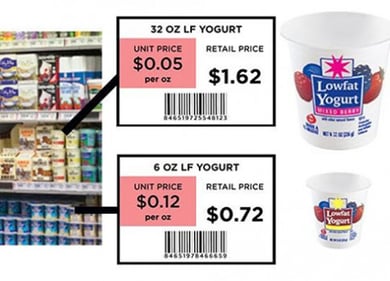Fire Up Your Savings Game: Saving Money at the Grocery Store
With prices rapidly rising on everyday items, perhaps your savings plan has gone by the wayside. These tips will help you find more money in your budget – starting with saving at the grocery store.
Inspired by content from our friends at GreenPath Financial Wellness, here's our take on the best ways to be saving money at the grocery store.
Tip # 1: Plan Before You Shop to Help with Saving Money on Groceries
Know what you have to spend: Set a budget or a dollar limit for each trip to the store or each order, and keep a running tally as you shop so you come in on budget. Scan & Pay options (Fry's has this!) allow you to take a handheld scanner with you throughout the store and eliminate all that mental math. ➕➖✖️➗
Make Your Grocery List
One of the most important parts of grocery shopping is pre-shopping planning. Before you go to the store, take inventory of what you already have, and make a list of what you need. If possible, plan meals you will prepare and check to see if you have all the necessary ingredients. Choose meals that use items that are affordable and ingredients that can be used in multiple ways – often if you can buy in quantity, you can save money overall. Plan for leftovers to take for lunch, or to eat later in the week. eMeals is a great meal planning tool that will create the grocery list for you, based on the meals & recipes you choose for the week.
Meal Plan + Snacks
A complete list is easier to stick to when you’re in the store. Plan for meals, snacks and needs that will carry you through until the next time you intend to shop. (If you shop every week, or every two weeks, buy what you need to make it that long.) Remember to also check on things like cleaning supplies, personal toiletries, or other household items you might need. The more times you go to the store throughout the week, the more you're likely to spend. So if you can make one trip last a week or more, go for it! As long as you have that list, of course. 😜
Cross-Reference Your List with Deals and Sales
Ok, we know not everyone has time for this. But maybe once a month you take a half hour to review local sales, coupons, specials, & extra points deals to help you save money, and then shop accordingly. Because you've already made your list, it's easier to go to the store and stick to it, even if that 30-pack of macaroni and cheese is screaming at you to purchase it. You can also sign up for free rewards programs at different grocery stores - such as Fry's VIP, Target Circle/RedCard, or Safeway for U to scan each time for additional savings.
Eat Before You Shop
Not that we'd know from experience, 😆 but shopping while hungry (or taking hangry children with you) tempts fate and you're way more likely to stray FAR from your list. Did I really need the extra-mega-family-size bag of Bugles? I don't even like Bugles!

Tip #2: Shop Around! Compare Prices from Different Stores
You have tons of grocery shopping options. Looking closely at them and finding the mix that works for you can help you balance your personal preferences, the kinds of things you need, and the price you are willing to pay. You may find out that by splitting your grocery list up between several options gets you the best deals. Or, you can alternate stores each week or month to stock up on items you need from that particular store.
Hello Unit Pricing!
Compare apples-to-apples by using the unit price as your comparison number: calculate the price per pound, ounce, or use: Price divided by pounds, ounces, uses (i.e., loads of laundry, sheets of toilet paper), etc. This is usually printed on the label. See image for example! ➡️
Consider (But Don't Commit) to Alternatives
Using online or alternative grocery services exploded in popularity as a result of the pandemic. The time savings and convenience is truly attractive and may be worth it, depending on your food values, budget, and proximity to in-person stores. Remember to include the delivery, subscription, or shipping costs for online orders versus transportation or fuel costs if you’re shopping in person.
Or, Stick to Traditional
Traditional supermarkets and superstores (think big names like Fry's, Walmart, Target, etc.) are familiar and convenient choices where you can compare pricing between different brands and accomplish a lot in one store.
Bulk, Bulk, Baby
Bulk retailers or wholesale clubs, like Costco or Sam’s Club might be a good way to stock up on quantity for a lower per-use cost. Remember to factor in that yearly membership fee, though! And you'll need to take into account that the upfront cost will be higher, so you may need to dip into next week's grocery money to foot the bill.
If you don't currently have a budget plan with allocated grocery money, we have a comprehensive, free budget plan eBook that will help you set that up. We also have a free budgeting template you can customize with your specific numbers!
Farmer's Markets
Buying direct through farmers markets, CSA shares (community supported agriculture), produce rescues, or purchasing a share of an animal might get you a lower price per pound for high-quality, fresh, local produce or meat. Bonus that it helps the environment to buy local, too. 🌳
Tip #3: Stick to Your List, Stick to Your List, Stick to Your List
We sound like a broken record, but sticking to your list is probably the most wallet-impacting move you can make to save money on groceries and hit your grocery budget. Your list is your plan, man.
Treat your list like your lifeline: stick to it and get yourself out of there!
"But what if I REALLY need something that's not on my list?!"
I mean, you do you. But one option is to make note of the things you wanted or felt like you needed that weren’t on your list, and when you’re safely away from temptation, re-evaluate and potentially add it to your list for your next shopping trip. This gives you some space to decide if it was really needed.
Tip #4: Beat Your Budget— Find the Best Deals on the Things You Need
You know what you need to buy because you made an awesome list. But how can you get the best deal on each of those items? Balance your total budget (how much you have overall to spend at the grocery store), with the best per-unit cost for each item. For example, if you only have $25 to spend, a years’ worth of toilet paper for $50 is not that helpful. But, if you can get a weeks’ worth of toilet paper for $1 less than normal, you just found $1.
• Know what things cost. Just because something is on sale doesn’t mean it’s a good deal. If you know that bananas cost 59 cents/pound, a $1 banana “sale” is not a good deal.
• Shop the sales for what you need. Watch for unadvertised specials that might get you a better price. Wait for something to go on sale to buy it.
• Buy things in quantity only when it makes sense. The larger bottle of mustard is probably a lower price per ounce than the tiny bottle, but buying a gallon jug might break the bank. Calculate the cost per ounce and compare.
• Save money by prepping things yourself. For example, a whole chicken might be less expensive per pound than boneless, skinless chick breast. Pre-packaged items often are more costly.
• Give the generic or store brand a try. Often they are lower in price and if you don’t like it, many stores will refund your money.
• When you check out, make sure you are being charged what you expected. If you think you are being overcharged, speak up. It never hurts to ask!
Tip #5: Stick to Your Plan at Home, Too. Use All of What You Buy
.png?width=800&name=grocery%20blog%20image%20(1).png)
Stretch those dollars even further by reducing or eliminating waste, so you can buy less often. And maximize your grocery purchases for the foods and supplies that meet your needs, and make your life easier, happier, and healthier. Keep going with these three "IZE". 👀
👀 Maximize (shelf life)
Process and store food to maximize shelf life. Store things in their ideal conditions to make them last if you need them to. If it’s something you won’t prepare for a week, freeze it to keep it fresh.
👀 Organize (food storage)
If it's easy to find, it's more likely you'll stick to the plan instead of throwing in the kitchen towel and ordering takeout. Label and date things and/or store them in containers that you can easily identify, so you don’t forget about them. When you take inventory before your next shopping trip, check the corners, drawers and hidden places.
👀 Prioritize (fresh food gets used first)
Stick with your menu plan! Make the recipes you planned to and use the fresh ingredients you bought with your hard-earned money when they are at their peak flavor and quality. If you're grocery shopping for a week or more at a time, plan to cook and use up fresh fruits, vegetables and protein first, leaving the meals that use frozen or shelf stable items for the following week.
If Your Grocery Bill
Is Putting You Underwater
If you find yourself paying for groceries on your credit card without the resources to pay that balance off, or if you're skipping meals so your kids can eat, then that is a different thing altogether.
Looking at your financial health, learning about your different options, and making a plan for your finances can relieve a huge amount of stress and anxiety – and help you figure out how to get where you want to be.
We want to help you achieve your goals! Our partner, GreenPath, has several caring Financial Wellness Experts. They're available to work with you and assess your specific situation to create a personalized plan. As a trusted national nonprofit for over 60 years, GreenPath works with thousands of people each week to pay off debt, improve credit, and lead a financially healthy life. If this sounds like it could help you, request a call today or simply pick up the phone and dial GreenPath at 877.337.3399 for a free, confidential consultation.
This article is intended to be a general resource only and is not intended to be nor does it constitute legal advice. Any recommendations are based on opinion only. Rates, terms and conditions are subject to change and may vary based on creditworthiness, qualifications, and collateral conditions. All loans subject to approval.

.png)


